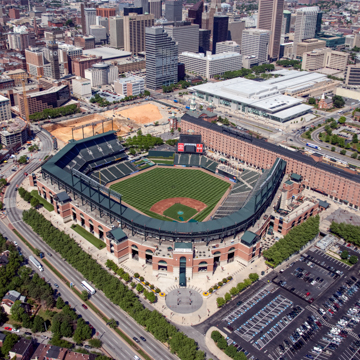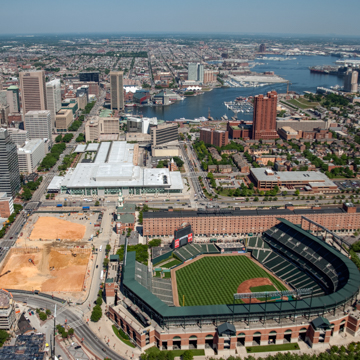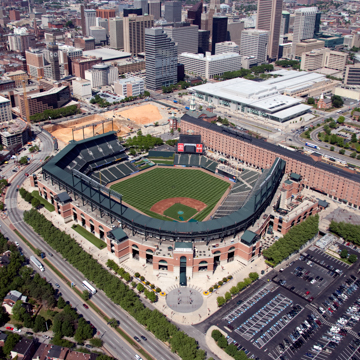Opened in 1992 as the home of the American League Baltimore Orioles and the first baseball-only Major League Baseball (MLB) stadium built in decades, Camden Yards had a profound influence on stadium design in the United States. It ushered in a new retro design approach inspired by vintage baseball stadiums while it also embraced its historic setting. The ballpark garnered widespread praise from fans, players, and architectural critics for its revival of baseball tradition, integration into the urban fabric, and stunning views of the Baltimore skyline.
Prior to construction of Oriole Park at Camden Yards, the Orioles played at Memorial Stadium (1922, Pleasants Penning-ton and Albert W. Lewis; demolished 2001), one of the first multipurpose stadiums of the mid-twentieth century. HOK Sport, a subsidiary of the firm Hellmuth, Obata and Kassabaum, initially considered various sites outside the city for a conventional multipurpose stadium replacement. Then the Orioles organization asked for a more traditional, baseball-only facility in downtown Baltimore, with the site at the Camden Station B&O Railroad yards ultimately inspiring a more creative and successful solution. Modern amenities such as skyboxes were combined with traditional baseball experiences such as an asymmetrical structure housing a grass field in an urban setting. The upper decks were supported on steel trusses instead of concrete, creating a visually lighter structure that recalled historic ballparks. The massive, four-block-long B&O warehouse (1898–1905, E. Francis Baldwin) at Camden Yards was renovated to house the Orioles’ offices and served as a unique backdrop for right field.
Oriole Park’s success directly inspired construction of a host of new retro-style ballparks in urban settings, with HOK Sport dominating this specialized design field. Now nearly every MLB team plays in a baseball-only park built between 1995 and 2015. The Camden Yards location of both Oriole Park and the stadium for the National Football League Ravens franchise (1996–1998, HOK Sport; 1101 Russell Street) expanded the adjacent Inner Harbor tourist and entertainment zone.
References
Loverro, Thom. Home of the Game: The Story of Camden Yards. Dallas, TX: Taylor Publishing, 1999.
Hayward, Mary Ellen, and Frank R. Shivers, Jr., eds. The Architecture of Baltimore: An Illustrated History. Baltimore: Johns Hopkins University Press, 2004.




















